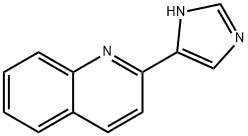2-(1H-IMIDAZOL-4-YL)-QUINOLINE
- CAS NO.:2054-67-3
- Empirical Formula: C12H9N3
- Molecular Weight: 195.22
- MDL number: MFCD08669166
- SAFETY DATA SHEET (SDS)
- Update Date: 2023-07-14 17:32:51

What is 2-(1H-IMIDAZOL-4-YL)-QUINOLINE?
Description
A quinoline alkaloid present in Macrorungia longistrobus C. B., the base crystal_x0002_lizes from Me2CO-hexane as colourless plates. The ultraviolet spectra have been extensively studied. In neutral solution (EtOH), the spectrum has absorption maxima at 214, 236, 264, 325 and 336 mfJ.. In acid solution (EtOH-HC1), the maxima occur at 215, 248, 257, 302, 315, 329 and 355 mfJ.. The picrate forms yellow needles from MeOH, m.p. 211-2°C (dec.). Treatment of the alkaloid with CH2N2 yields a mixture of Macrorine (q.v.) and isomacrorine.
References
Jordaan, Joynt, Arndt., J. Chern. Soc., 3001 (1965)
Joynt et al., J. Chern. Soc., B, 980 (1966)
Properties of 2-(1H-IMIDAZOL-4-YL)-QUINOLINE
| Melting point: | l56-7°C |
| Boiling point: | 481.4±25.0 °C(Predicted) |
| Density | 1.270±0.06 g/cm3(Predicted) |
| pka | 11.15±0.10(Predicted) |
Safety information for 2-(1H-IMIDAZOL-4-YL)-QUINOLINE
Computed Descriptors for 2-(1H-IMIDAZOL-4-YL)-QUINOLINE
New Products
Tert-butyl bis(2-chloroethyl)carbamate (S)-3-Aminobutanenitrile hydrochloride N-Boc-D-alaninol N-BOC-D/L-ALANINOL N-octanoyl benzotriazole 3,4-Dibenzyloxybenzaldehyde 4-Hydrazinobenzoic acid 1,1’-CARBONYLDIIMIDAZOLE R-2-BENZYLOXY PROPIONIC ACID 3-NITRO-2-METHYL ANILINE 4-IODO BENZOIC ACID 4-HYDROXY BENZYL ALCOHOL 4-(3-chloropropyl)morpholine phenylhydrazine hydrochloride (2-Hydroxyphenyl)acetonitrile 4-Bromopyrazole 5-BROMO-2CYANO PYRIDINE 5,6-Dimethoxyindanone 5-broMo-2-chloro-N-cyclopentylpyriMidin-4-aMine 4-methoxy-3,5-dinitropyridine 2-(Cyanocyclohexyl)acetic acid 2-aminopropyl benzoate hydrochloride 1-(4-(aminomethyl)benzyl)urea hydrochloride tert-butyl 4- (ureidomethyl)benzylcarbamateYou may like
-
 (9H-fluoren-9-yl)methyl (2,5-dioxopyrrolidin-1-yl) carbonate 82911-69-1 98.0%View Details
(9H-fluoren-9-yl)methyl (2,5-dioxopyrrolidin-1-yl) carbonate 82911-69-1 98.0%View Details
82911-69-1 -
 13057-17-5 95.0%View Details
13057-17-5 95.0%View Details
13057-17-5 -
![2-Nitro-8,9-dihydro-5H-benzo [7] annulen-7(6H)-one 98.0%](https://img.chemicalbook.in//Content/image/CP5.jpg) 2-Nitro-8,9-dihydro-5H-benzo [7] annulen-7(6H)-one 98.0%View Details
2-Nitro-8,9-dihydro-5H-benzo [7] annulen-7(6H)-one 98.0%View Details
740842-50-6 -
 4-bromoaniline 106-40-1 99.0%View Details
4-bromoaniline 106-40-1 99.0%View Details
106-40-1 -
 1421517-99-8 99.0%View Details
1421517-99-8 99.0%View Details
1421517-99-8 -
 5-bromo-2-chlorobenzoic acid 99.0%View Details
5-bromo-2-chlorobenzoic acid 99.0%View Details
21739-92-4 -
 2-methyl-5-nitrophenol 98.0%View Details
2-methyl-5-nitrophenol 98.0%View Details
5428-54-6 -
 15761-38-3 97.0%View Details
15761-38-3 97.0%View Details
15761-38-3
Statement: All products displayed on this website are only used for non medical purposes such as industrial applications or scientific research, and cannot be used for clinical diagnosis or treatment of humans or animals. They are not medicinal or edible.